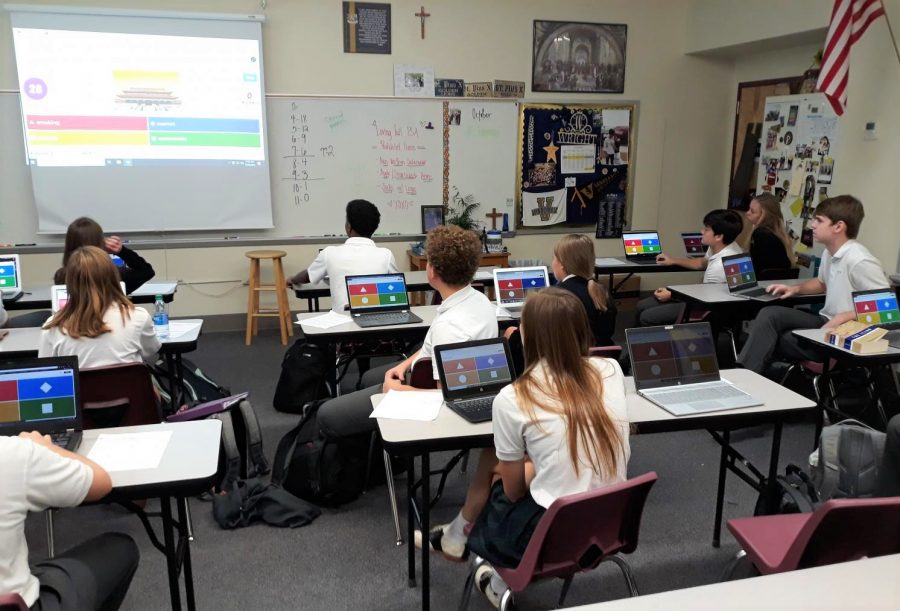Which classroom review game is king?
A ranking of the top 5 in-class review games
Sophomores in Mrs. Rose’s 4th period AP World History class play Kahoot to help review for an upcoming test.
December 3, 2019
It’s no secret that school can be monotonous. Sometimes it can seem like there is always a test, always an essay, always some more work to be done. This is where review games come in, as a brief respite from the more mundane ways of studying.
Some of the most popular review games are Kahoot, Jeopardy, Quizlet Live, Quizizz, and Gimkit. Like everything else in life, some of these review games are better than others. This list includes five games rated on five different elements; the time it takes to play, the pace of the game, if a performance report is given, general ease of use, and overall amusement.
5. Jeopardy – 0/5
Jeopardy is the only review game on this list where each question is only seen once by the participant, and to play through an entire game of Jeopardy can take an entire class period. This means participants will be spending the most amount of time for the least amount of review. Jeopardy also does not have a performance report at the end of the game, so participants cannot see which questions they need to study more. The only significant benefit of Jeopardy is it has the most total winners in the end since one team is half of a classroom.
4. Quizizz – 3/5
Quizizz is not exceptionally good or bad, and it’s the most basic of games on this list. Questions appear on a participant’s screen, they answer, and they have points awarded for answering. It’s tediously straightforward. The upside of this method is that participants can go at their own pace and think about their answers. Quizizz also displays an individual performance report at the end of each game that shows the average time it takes to answer a question and lets the participant review which questions they answered incorrectly. Overall, Quizizz is just a basic review game with nothing exciting or different.
3. Quizlet Live – 3.5/5
Both Jeopardy and Quizlet Live are primarily team-based games. Unlike Jeopardy, though, Quizlet Live has multiple smaller groups and therefore doesn’t take an entire class period to play. Every participant on a team sees every question, and, even though they might not be the one answering, every answer. Quizlet Live also has a fairly quick pace so participants usually see every question more than once, which is really good if you are trying to master the study set. Quizlet Live’s biggest advantage, however, is that any set used in a game can be studied individually later. So not only does Quizlet Live work really well as a review game, it greatly helps with review outside of class. These factors combine to make Quizlet Live possibly the most played review game on this list, and justly so.
2. Gimkit – 4.5/5
Just barely in second place lies Gimkit and its distinctive approach to the review game. Gimkit is by far the most polarizing review game ever-either you love it or you loathe it. Gimkit’s biggest drawback is that usually the same students win over and over again. This contributes to the polarizing effect of Gimkit because the people that tend to prefer it also tend to win. Gimkit’s most unique aspect is its game design; in a Gimkit game, participants need to worry about more than just answering questions correctly. Between each question, participants are given the option to purchase upgrades using the cash they earn through questions. This extra aspect of time and money management gives Gimkit a creative twist that can make it extremely fun if you know how to play efficiently. For those who struggle to master this aspect, however, Gimkit can be rather infuriating.
1. Kahoot – 5/5
You can’t go wrong with Kahoot, the original review game. Kahoot is the fastest-paced game on this list, which in turn makes it one of the most competitive games. During a round of Kahoot, the lead can change instantly, and to win participants need to be ready for anything. This element of unpredictability with the lead is what makes Kahoot great. Even it’s music is fantastic, and the Kahoot jingles can get stuck in your head for hours. Making a Kahoot game is also remarkably effortless, allowing anyone with a free account to create their own set. Additionally, Kahoot offers a multitude of options for customizing your quiz: how long a question is visible, background images, how much a question is worth, and more. The sole flaw with Kahoot is that sometimes the pace is too fast, and the participants might not learn as much. But compared to all of the fun involved with a Kahoot game, this flaw is of minor consequence.






